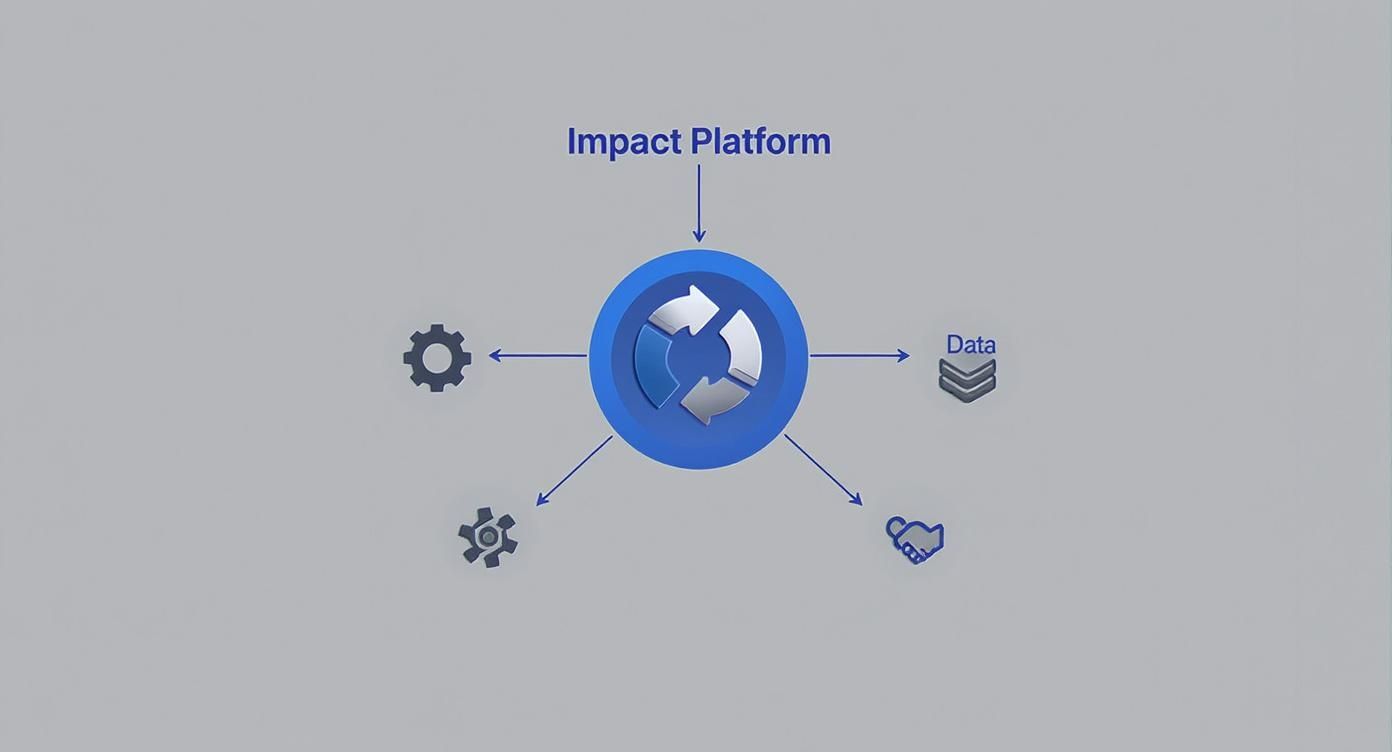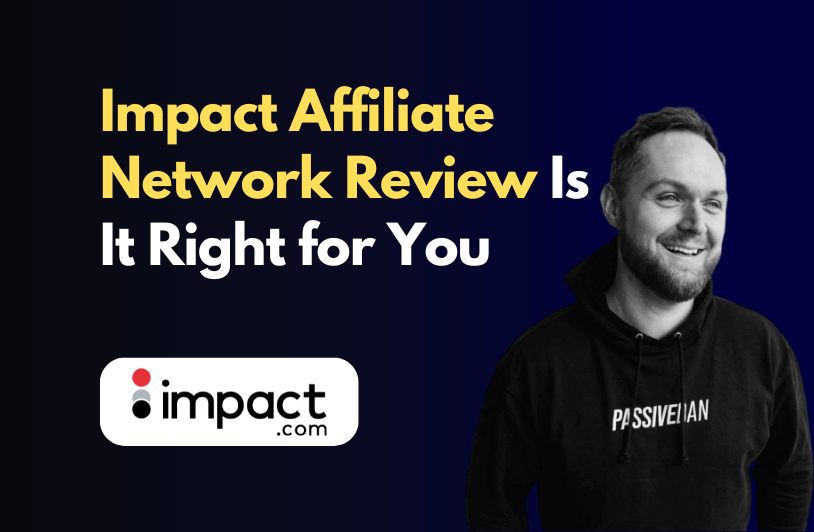If you’ve been looking for an Impact affiliate network review, let me cut to the chase: Impact.com is the real deal for anyone serious about growing their business through partnerships. It’s built to manage everything—from your standard affiliate marketers to big-name influencers and even complex B2B deals—all in one place. What really sets it apart is its powerful automation and tracking, which is frankly a cut above most of what’s out there.
What Is the Impact Affiliate Network
Here’s the thing you need to understand about Impact: it’s not just another affiliate network. It’s a full-blown partnership management platform.
Most traditional networks are just marketplaces. They connect brands with publishers, and that’s about it. Impact is different. It provides the actual software and infrastructure for brands to build and manage their own partnerships directly, from start to finish.
This is a huge distinction. Instead of just tossing your offer into a massive, impersonal pool, Impact lets brands and partners create direct relationships. You can negotiate contracts, track performance with incredible detail, and handle all the payments without ever leaving the dashboard. It’s about way more than just simple affiliate links.
Just a quick look at the Impact.com homepage shows you what they’re all about—they’re focused on the entire “partnership economy,” not just one slice of it.
The whole platform is designed for growth through all kinds of partnerships, pushing way beyond what we think of as conventional affiliate marketing.
More Than a Network, It’s a Technology Platform
The real secret sauce of Impact is its technology. For brands, it offers a powerhouse suite of tools that automate the grunt work and give you data you can actually use. For publishers and creators, it means transparency and a direct line to high-quality brands. This tech-first approach is exactly what the industry needs right now.
The affiliate marketing space is exploding, projected to hit a massive $31.7 billion by 2031. And with over 80% of advertisers already relying on it, the demand for sophisticated, powerful platforms to manage it all is only going up. You can dig into more of these affiliate marketing statistics on Hostinger.com.
For anyone trying to wrap their head around how different companies structure their programs, it’s always a good idea to explore other affiliate programs to see what’s working out there.
At the end of the day, Impact is built for businesses that see partnerships not as some small side-hustle, but as a core engine for growth. If you need precision, control, and the ability to scale, this is where you’ll find it.
How the Core Features Drive Growth
To really get what Impact is about, you can’t just scroll through a feature list. It’s more about understanding how the whole system works together as a growth engine for your business, turning partnerships into real, trackable revenue. The entire platform is built around two key ideas: bringing everything together and making it crystal clear.
The heart of this is the Partnership Cloud. Don’t just think of it as another network. It’s more like a central command center for every single partner you work with—from your classic affiliates and B2B partners to social media influencers and mobile app developers. This unified setup gets rid of data silos, giving you one single, reliable source of truth for your entire partner ecosystem.
Advanced Tracking and Attribution
One of the features that really stands out is Impact’s tracking technology. A lot of networks are still stuck on the old “last-click” attribution model. That’s like giving all the credit for a big sale to the final salesperson who closed the deal, completely ignoring the team that spent weeks warming up the lead.
Impact, on the other hand, gives you multi-touch attribution. This model paints a complete picture of the customer’s journey, showing you exactly how different partners influenced a sale along the way. That level of clarity is huge for rewarding partners fairly and putting your marketing dollars where they’ll get the highest ROI. Of course, even the best tracking won’t help if your landing pages don’t convert, a topic I cover in my guide on affiliate marketing landing pages.
This infographic breaks down how Impact’s platform is built on three pillars: automation, data, and relationship management.

You can see how all the features are designed to work together, creating a seamless system for managing and scaling your partnerships.
Automation That Frees Up Your Time
Growth comes to a screeching halt when you’re drowning in manual tasks. Impact solves this with some pretty powerful automation features that can handle the entire partnership lifecycle for you.
- Automated Contracting: You can set up, negotiate, and manage contracts right inside the platform. No more endless email chains.
- Global Payment Processing: Impact takes care of the headache of paying partners in different countries and currencies, making sure everyone gets paid on time and accurately.
- Workflow Automation: You can build rules to handle repetitive stuff like onboarding new partners, sending out communications, or adjusting commissions based on performance.
This isn’t just about saving time; it’s about running a more professional and scalable program. And when you combine Impact’s features with broader strategies to increase online sales, you can really amplify your results.
This kind of automation is especially critical in today’s global market. North America is the biggest player, making up 40–45% of the affiliate ecosystem, but Europe is right behind with around 30%, and the Asia-Pacific region is growing like crazy. If you want to tap into those markets, you need a platform that can handle international payments and contracts without you having to think about it.
By transforming raw performance data into actionable insights, Impact’s analytics suite empowers businesses to move beyond guessing and start making data-driven decisions that directly contribute to scaling partnerships and improving profitability.
At the end of the day, the features inside Impact are built for more than just management. They’re designed for strategic growth, helping you turn your partnership program from a line item on your budget into a major driver of your business.
Understanding the Impact Pricing Model
So, how much does Impact actually cost? This is one of the first questions everyone asks, but you won’t find a neat little pricing page on their website. There’s a good reason for that.
Impact doesn’t sell a one-size-fits-all product. Think of it less like buying off-the-shelf software and more like bringing on a specialized agency. The pricing is completely custom and built around your business—your scale, your goals, and what you’re trying to achieve.
This approach immediately tells you who Impact is for. It’s a premium platform designed for established mid-market and enterprise companies. If you’re just starting out or have a tight budget, it probably isn’t the right fit just yet. But for businesses ready to seriously scale their partnerships, the investment matches the power you get.
Breaking Down the Core Costs
While your final quote will be unique to you, Impact’s pricing generally breaks down into three parts. Getting a handle on these will help you see exactly where your money is going.
- One-Time Integration Fee: This is your upfront setup cost. It covers all the technical heavy lifting to get Impact connected to your systems, making sure your tracking and data are flowing perfectly from day one.
- Monthly SaaS Fee: This is the regular platform license fee. It’s what gives you access to the software itself. The price here depends on the specific features you need, how complex your program is, and how much you’ll be using it.
- Commission Override: Impact also takes a small percentage on top of the commissions you pay your partners. This is pretty standard for platforms that handle all the payment processing and the financial backend of a large-scale program.
At the end of the day, the investment in Impact is tied directly to what it can do for your business. You’re paying for seriously sophisticated tech that gives you deep insights, automates workflows that would otherwise be a nightmare, and lets you manage everything—from influencers to B2B deals—all in one spot.
The pricing really reflects that Impact is more than just a simple affiliate network; it’s a full-blown partnership management engine. The cost is designed to line up with the massive ROI you can get from a well-run, scalable, and diverse partner program. If you’re serious about turning partnerships into a primary revenue channel, you’ll see a clear return on this investment.
Evaluating The Pros And Cons Of Impact
Let’s be real—no platform is a magic bullet for everyone. This Impact affiliate network review wouldn’t be honest without digging into both its strengths and its weaknesses. Figuring out if it’s the right fit for your business means looking at both sides of the coin.
Think of it like this: Impact gives you the keys to a high-performance workshop full of specialized machinery. It’s incredibly powerful. But not everyone needs a CNC machine just to hang a picture, and the price tag reflects that power.
The Clear Advantages Of Impact
The best parts of using Impact come down to its serious tech and the strategic freedom it gives you. It’s built for businesses that are ready to make partnerships a core part of their revenue strategy.
- Exceptional Automation and Efficiency: Impact is a master at automating all those little, repetitive tasks that eat up your time. From sending out contracts to processing global payments, it handles the administrative grunt work. This frees up your team to do what they do best: build relationships and think strategically.
- Best-in-Class Tracking Technology: This is a huge one. Impact’s tracking and attribution are top-notch. It goes way beyond the old “last-click wins” model, giving you a much clearer, multi-touch view of the entire customer journey. You can finally reward partners fairly and know exactly where your marketing dollars are working hardest.
- Unmatched Partnership Flexibility: Impact isn’t just for classic affiliate marketers. It’s designed to manage your entire partnership ecosystem. We’re talking influencers, brand-to-brand deals, mobile app collaborations, and more, all managed from one central dashboard. It becomes the single source of truth for all your partnership efforts.
This kind of robust platform is becoming more critical as the market grows. With affiliate marketing projected to expand at a CAGR of 18.6% from 2023 to 2032, and businesses earning an average of $6.50 for every $1 invested, you need a solid foundation to capture that ROI. You can discover more insights about these affiliate marketing stats on FirstPromoter.com.
Potential Drawbacks To Consider
As powerful as it is, Impact has its downsides, especially if you’re a smaller or newer business. It’s crucial to weigh these challenges before you jump in.
The biggest hurdles with Impact aren’t about what the platform can do, but who it’s for. The financial commitment and the time it takes to learn the system can put it out of reach for companies just starting their affiliate journey.
Here are the main things to keep in mind:
- Significant Financial Investment: Impact is a premium platform, and it’s priced like one. You’re looking at a one-time integration fee, a monthly SaaS fee, and commission overrides. It’s a serious investment best suited for established mid-market to enterprise-level companies.
- Considerable Learning Curve: This is not a “plug-and-play” tool you master in an afternoon. To really get your money’s worth, you need to dedicate a team member or manager to learn the system inside and out. For a different take, our Awin affiliate network review looks at a platform that’s often seen as more straightforward for beginners.
- Often Overkill for Small Businesses: If you’re a startup just dipping a toe into affiliate marketing, Impact is probably more firepower than you need. The advanced features are great, but they might be unnecessary if your program is still small and doesn’t involve complex, multi-channel partnerships.
Impact vs. Key Competitors (CJ Affiliate, Rakuten Advertising)
So, how does Impact really stack up against the other big names in the affiliate world? While they all connect brands with publishers, their core strengths and target users are quite different. This table gives you a quick, high-level look at where each platform shines.
| Feature | Impact.com | CJ Affiliate | Rakuten Advertising |
|---|---|---|---|
| Best For | Enterprise & Mid-Market brands wanting a unified partnership platform. | Established brands with a large, diverse affiliate program. | Premium & lifestyle brands focused on curated, high-quality publisher relationships. |
| Partnership Types | Affiliates, Influencers, B2B, Mobile Apps, Content Creators (All-in-one). | Primarily traditional affiliates, content publishers, and coupon/deal sites. | Strong focus on content creators, loyalty sites, and premium publishers. |
| Tracking & Attribution | Advanced multi-touch attribution, cross-device tracking. | Solid last-click and multi-touch capabilities, but less flexible than Impact. | Reliable tracking, but generally considered less advanced than Impact. |
| Pricing Model | SaaS fee + Integration fee + Commission override. | Primarily network commission fees, sometimes with setup or monthly fees. | Network commission model, often with performance-based incentives. |
| User Interface | Modern, data-rich, and highly customizable, but has a steep learning curve. | A bit dated but functional and familiar to experienced affiliate managers. | Clean and generally user-friendly, but can feel limited in customization. |
Ultimately, the choice comes down to what you need right now. Impact is the forward-thinking choice for businesses scaling their entire partnership ecosystem. CJ and Rakuten, on the other hand, are well-established powerhouses in the more traditional affiliate marketing space.
A Practical Onboarding Walkthrough
Jumping into a platform as powerful as Impact can feel a little intimidating at first. Let’s be honest, the dashboard has a lot going on. But breaking down the onboarding process into clear, manageable steps makes it way less daunting.
Whether you’re a brand looking to launch a killer affiliate program or a creator searching for your next big partnership, the initial setup is a pretty structured journey. This walkthrough will pull back the curtain on those first steps for both sides of the coin.

Think of this section as your action plan. We’re turning abstract ideas into a concrete “what to expect on day one” guide.
The Onboarding Journey For Brands
For businesses, getting started on Impact is a strategic process that begins long before you even log in. It’s all designed to make sure your program is built on solid ground.
- Sales Call and Contracting: It all starts with a chat. You’ll have a consultation with the Impact team to talk through your goals and get a custom quote. Once you’re happy with the terms, you’ll sign the contract and officially kick things off.
- Technical Integration: This is probably the most crucial technical bit. You’ll work with Impact’s team to get their tracking pixel, the Universal Tracking Tag (UTT), placed on your website. This little piece of code is the magic that lets Impact accurately track every single click, conversion, and action your partners drive.
- Program Setup and Customization: Now for the fun part. With the tech side sorted, you get to build your program’s public profile. This means writing a compelling description to attract the right partners and clearly spelling out your terms and conditions.
- Commission Structure and Assets: Here’s where you decide how your partners get paid. You might set up a flat CPA (Cost Per Action), a percentage of sales, or maybe even a hybrid model. You’ll also upload all the essential marketing assets—banners, logos, and promotional text links—for your partners to grab and use.
This initial setup is your program’s first impression. A well-defined description, competitive commission rates, and high-quality creative assets are absolutely essential for attracting top-tier affiliates who can genuinely move the needle for your brand.
The Onboarding Path For Affiliates
If you’re an affiliate, publisher, or content creator, getting started is much more straightforward. The platform is built to get you connected with brands and earning commissions as quickly as possible.
- Network Application: Your first move is to apply to join the Impact network. You’ll fill in details about your website, social channels, audience, and how you plan to promote products. Once approved, you’ve got access to the entire marketplace.
- Discovering Brands: With your access granted, you can dive into the marketplace and start hunting for brands that fit your niche. The platform’s search and filter functions are great for narrowing down programs by category, commission rates, and other key criteria.
- Applying to Programs: Find a brand you want to promote? You’ll submit an application directly to their program. Some brands have instant approvals set up, while others will manually review your profile before giving you the green light.
- Accessing Promotional Tools: Once you’re in, you get the keys to the castle. You can generate unique tracking links for specific products, grab banner ads, and find any available coupon codes to share with your audience. You’re now ready to start earning.
Our Final Verdict on the Impact Network

So, what’s the bottom line? After digging deep into everything Impact has to offer, my verdict is pretty clear: it’s a phenomenal, enterprise-level partnership platform, but it is absolutely not for everyone.
Think of it like this: Impact is a professional film studio. It’s got all the high-end cameras, lighting, and sound equipment you could ever dream of. It’s immensely powerful for a major production, but it’s complete overkill if you’re just trying to shoot a quick video on your phone.
The platform really shines for specific types of businesses that are ready to treat partnerships as a core part of their revenue strategy. If you fall into one of the categories below, the investment is almost certainly going to pay off.
Who Is a Perfect Match for Impact?
- Enterprise-Level Brands: If you’re a large company juggling a complex web of global partnerships, Impact is your command center. Its automation and reporting capabilities are built from the ground up to handle that kind of scale.
- SaaS and Tech Companies: Got an intricate partner program with things like B2B referrals and tiered rewards? Impact’s flexible tech lets you build and manage sophisticated systems that more traditional networks simply can’t handle.
- Businesses Scaling Mature Programs: Maybe you’ve outgrown simpler platforms. If you’re hitting a wall and need advanced tracking, multi-touch attribution, and the power to manage influencers alongside traditional affiliates, Impact is the logical next step.
Who Should Look Elsewhere?
On the flip side, some businesses should probably steer clear for now.
If you’re a startup or a small business on a tight budget, the financial commitment is likely going to be a deal-breaker. The sheer number of features can also feel overwhelming if you’re just dipping your toes into partnerships. It’s much wiser to focus on your core growth first.
For creators, Impact is a fantastic place to connect with high-quality brands. But it’s crucial to diversify and not put all your eggs in one basket—that’s a key lesson for anyone serious about successful affiliate marketing for bloggers. The platform opens the door, but it doesn’t manage the relationships for you.
Ultimately, Impact is for those who have the resources and a solid strategy to actually use its powerful toolset. If that’s you, it’s a game-changer. If not, there are better places to start.
Frequently Asked Questions
When you’re digging into a platform like Impact, a few questions always seem to pop up. Let’s clear up some of the most common ones I hear so you can get the last few details you need.
Is Impact The Same As A Traditional Affiliate Network?
No, and it’s a really important difference to understand. Think of a traditional affiliate network as a big, open marketplace where brands and publishers find each other. Impact isn’t that. It’s a technology platform.
What that means is brands use Impact’s tools to build and run their own private partnership programs. You get way more control over who you work with, the contracts you set, and how everything is tracked. It’s less like being listed in a public directory and more like building your own custom partner ecosystem from the ground up.
What Kind of Partnerships Can You Manage on Impact?
This is where Impact really shines. It’s built for way more than just classic affiliate bloggers. The whole idea is to manage the entire “partnership economy,” which can include pretty much anyone who drives value for your brand.
- Influencers: Everyone from the big names to the niche micro-creators on Instagram, TikTok, or YouTube.
- Content Publishers: Your traditional bloggers, review sites, and major media outlets.
- B2B Partners: Think strategic business partnerships or formal referral programs.
- Mobile Apps: Partners who specialize in driving app installs or getting users to take specific in-app actions.
Honestly, this flexibility is its biggest strength. You can bring every single partner relationship under one roof. That gives you a single, clear picture of all your partnership revenue, something you just don’t get with simpler, old-school networks.
What Is The Customer Support Like?
For brands, the support is pretty solid, especially when you’re first getting set up. They usually give you a dedicated account manager to walk you through the technical side of things and help you get your program structured for success.
For affiliates and publishers, the support team is generally quick to respond to platform bugs or technical questions. But here’s something you need to know: Impact sees itself as the facilitator, not the referee. If you have a dispute with a brand over a payment or something in your contract, Impact’s stance is typically that the two of you need to work it out directly. It’s a hands-off approach that’s worth keeping in mind.
Ready to stop guessing and start building a profitable affiliate business with a proven system? At Daniel Proctor, I provide the mentorship, tools, and step-by-step guidance you need to succeed. Start my free affiliate marketing masterclass today!

